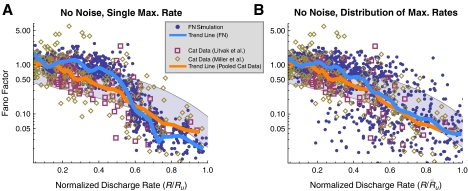FIG. 6.
Removing ongoing noise improves aspects of the FN model’s irregularity prediction. A The Fano factor versus the discharge rate for electrically stimulated auditory nerve fibers (Litvak et al. 2001 data, open boxes; Miller et al. 2008 data, open diamonds) and the FN model without ongoing noise (points). In panel B, predictions of the FN model are scaled to account for the distribution of maximum discharge rates measured in electrically stimulated auditory nerve fibers (Zhang et al. 2007). Curves represent loess trend line fits (Cleveland 1993) to the auditory nerve data (combined across experiments) and to the FN data, respectively. The auditory data consists of a total of 300 data points collected from 114 fibers (Litvak et al. 2001; Miller et al. 2008). Approximately 950 data points are shown for the FN simulations. Points within the gray region fall between the 1% and 99% quantiles of a dead-time modified Poisson process. The modified Poisson dead times are 2 ms for the auditory nerve data, as in Litvak et al. (2001) and Miller et al. (2008), and 0.67 ms for the FN model. Values of Ru ( in B) are 393 spikes/s and 1,174 spikes/s for the auditory nerve data and the FN model, respectively.
in B) are 393 spikes/s and 1,174 spikes/s for the auditory nerve data and the FN model, respectively.

